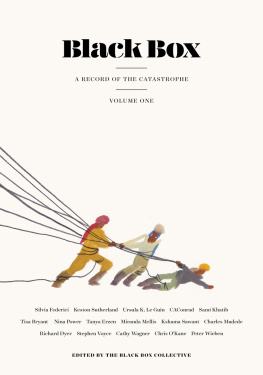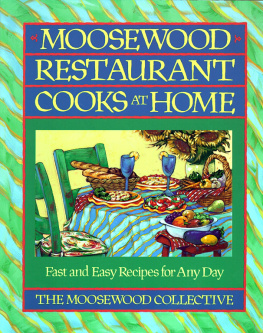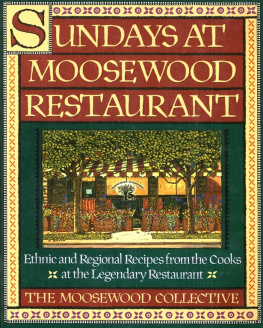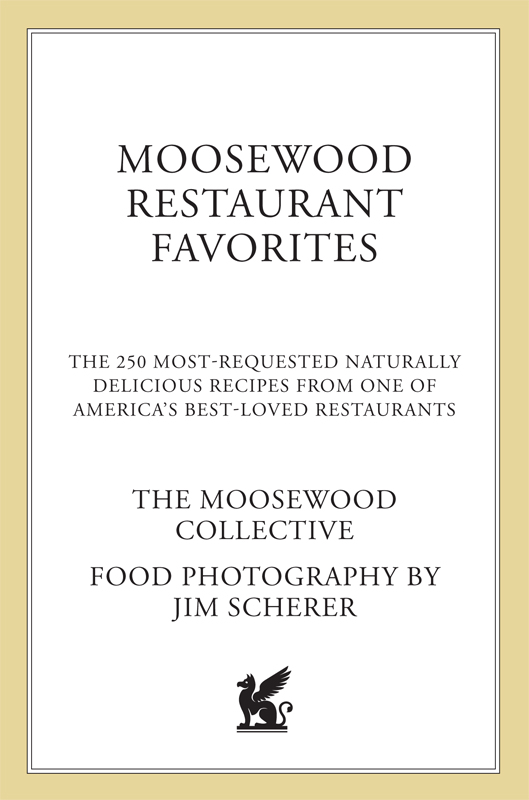
The author and publisher have provided this e-book to you for your personal use only. You may not make this e-book publicly available in any way. Copyright infringement is against the law. If you believe the copy of this e-book you are reading infringes on the authors copyright, please notify the publisher at: us.macmillanusa.com/piracy.
Contents
This book is dedicated to all Moosewood cooks.
Acknowledgments
The food that fills this book has been influenced by all of the people who have cooked in the Moosewood kitchen and everyone who has influenced each of themfamily, friends, neighbors, cookbook authors, strangers on airplanes, cooks in other restaurants. We continue to learn from each other in a wonderfully organic way. Were grateful to all those who use our cookbooks and take the time to tell us how important our books are to them, to thank us for a particular recipe, or to tell us their favorite way to make one of our dishes.
Having Arnold and Elise Goodman as our literary agents has been wonderful for us. From our first foray into the cookbook world and straight through to today, they have been excellent advocates and constant and generous friends. With affection and gratitude we say, Thank you, Arnold and Elise.
Michael Aman, in our first cookbook we thanked you for helping us prepare the manuscript, for your careful, discerning eye as you typed our handwritten recipes on a Smith Corona Electric Selectric, and we thank you again now for the hours you spent checking this books recipes. Youre a true friend. Sam Adler, thank you for your sense of humor and for both okaying and tempering ours. Kip Wilcox, youre a wonderful cook and you stepped up just when we really needed you. Emilio Del Plato, as our technical abilities very slowly improve, we need to call on you less, but you know were happy youre there. Thank you all.
St. Martins Press. On the day we first walked into the St. Martins offices, we were anticipant, eager to see if we were a good fit for each other. At first, we were mainly excited to be in the Flatiron Building, but soon, it wouldnt have mattered where we were. What a lovely group of talented and dedicated people.
Michael Flamini, our gem of an editor. In a previous life, Michael must have been a shepherd, one who loved and cared well for each of his sheep, one with good instincts for the greenest pastures. Michael is boundless in his energy and enthusiasm, not only for our book and the path he forges for it, but best of all he is passionate about good food wherever he finds it. Bon appetit, Michael.
And thank you, Vicki Lame. You always come through for us.
For their generous support of our project, were grateful to Sally Richardson, Matthew Shear, and George Witte. And then there is our copyeditor, Leah Stewart, and the production people, Adriana Coada, Elizabeth Curione, Phil Mazzone, James Sinclair, Amelie Littell, Susan Joseph, and Karen Gillis. And Olga Grlic, who designed the cover. Lisa Senz and Sarah Goldstein and Nadea Mina, who are taking this book out into the marketplace.
For the beautiful, lush photographs of food, we thank photographer Jim Scherer and food stylist Catrine Kelty. They are artists and such a pleasure to work with. The glowing photo of the restaurant on the inside cover and the photo of the Moosewood Collective were taken by someone dear to us, Justin Zoll, who, while working at Moosewood, has become an amazing photographer, lucky us.
Introduction
Moosewood Restaurant has been serving delicious food for forty years now, with a menu that changes at every meal. We have written a dozen cookbooks that all together contain about 3,000 recipes. Sometimes at book signing events, Moosewood fans say, Another one? How can you come up with more? Well, for us, theres truth in that old Italian saying, A tavola non sin vecchia, which translates as You never grow old at the table or It never grows old, being at the table. After spending most of our adult lives cooking, searching for food ideas, experimenting, learning, evolving, and cooking some more, were still eager to taste something new and to think about how we might improve something old and beloved.
During Moosewoods forty years, the culinary landscape all around us has changed dramatically. In 1973 when Moosewood began, yogurt was advertised as a newly discovered secret-of-longevity food from Russian Siberia where the majority of elderly people were reported to be centenarians. Many of our customers tried it for the first time at the restaurant. In the mid-1980s, when we were putting together New Recipes from Moosewood Restaurant , coconut milk was unusual and unavailable enough that we included a recipe for how to make it from fresh coconut so that any reader could try our recipes that included it. Now you can easily find low-fat and full-fat and organic coconut milk, and even coconut water. And now, many supermarkets have a whole aisle of soy, almond, and rice milks.
In our first few cookbooks, we hesitated to call for fresh herbs exclusively in a recipe, because in many areas of the country you could only find dried herbs in little cans, and fresh herbs, when you could find them, were very expensive. Many of us remember vividly the first time we tasted cilantro. It was so emphatically a brand new flavor, often tasting at first like either soap or aluminum, and then after the third or fourth exposure, like something we never wanted to do without again.
The Maine Organic Farmers and Gardeners Association, the oldest and largest state organic organization in the country formed in 1971, and in 1973, fifty-four farmers in California got together, agreed upon standards for producing organically grown produce, and mutually certified each other as organic growers. Awareness of the benefits of organic farming was ground-breaking, even revolutionary, then. Today, most supermarkets have a space that is devoted to organic produce, and farmers markets and CSAs, with their organic, local, and heirloom fruits and vegetables, are wildly popular.
You could always find cabbage at the store forty years ago, but today you can expect to find four different kinds of cabbage plus bok choy, mizuna, kale, collards, broccoli rabe, turnip and beet greens, escarole, endive, and maybe fresh cactus paddles. Now, you might even stand in the produce aisle and use your smartphone to find shopping information about cardoons or a recipe for tatsoi. Who could have guessed?
When Moosewood opened, every night we served a simple saut of fresh vegetables, maybe with tofu, over brown rice. Our parents worried about our vegetarian diets because surely you arent getting enough protein! The first USDA dietary guidelines for Americans didnt come out until 1980, and at that time animal protein dominated the picture. The USDA guideline in 2010 recommends filling the majority of your plate with plant foods. At last, a diet of grains, vegetables, fruits, and beans is officially recognized as the most healthful.
Most of us at Moosewood grew up in cities or suburbs, and as young adults many of us identified in some way with what was called the back-to-the-land movement. We built handcrafted houses and learned to garden organically, preserve food, and bake bread. We supported ourselves in small alternative businesses, like Moosewood, interested in fostering community spirit, supporting local farming and environmental consciousness, and offering food made from the freshest, most wholesome ingredients. This sounds like the plan for many new restaurants today, but it wasnt the norm back then.







